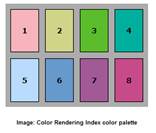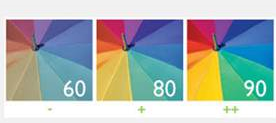The colour rendering index at the LED test bench
Download the PDFLED lights bear a three-figure photometric code. One of these figures is a colour rendering index. Explanations.
What is colour rendering?
In our environment, we perceive the colours of objects according to the light source that illuminates them. They absorb, release or reflect coloured radiation, thereby creating a sensation of colour.
In nature, this radiation is produced by the sun’s rays. They form the visible spectrum, or white light. A green pencil looks green because it absorbs all of the wavelengths contained in white light, except for green, which it reflects. This is called colour rendering.
In order to avoid altering our perception with artificial light sources, lighting professionals must ensure the quality of the white light of their lighting solutions. For this purpose, the International Commission on Illumination (CIE) has developed a measurement method in the form of a colour rendering index, or CRI.
The colour rendering index: a key value in lighting engineering
In lighting engineering, the CRI enables colour rendering using a tested light source to be compared with rendering under natural light. It is calculated between 0 and 100 with a palette of 8 colours (R1 to R8), with 100 being the CRI that can reproduce all colour shades, and 0 being the absence of all recognizable colours.

Color Rendering Index color palette
How to select a suitable CRI?
It depends on the intended use. A CRI of 20 is sufficient for the illumination of a parking lot, but it should be increased to 40 for a hallway, to 80 for living areas, and even higher for precision trades such as medicine or watchmaking.

The CRI must not be confused with colour temperature. Also found in the photometric code, this value defines the general hue of the white: a cold hue above 6000K, and warm at 2700K. Changing the phosphorescent powder for warm whites increases the emission of lower wavelengths (orange-red). This often produces better CRIs, although rendering may be lower (~10% loss, or 5 points of CRI).
CRI and LED lighting, a question of realism
CRI calculation was standardized in the 1950s to test fluorescent and discharge lamps. The procedure is poorly suited for the more recent LED technologies.
LEDs emit a discontinuous spectrum which distorts the value of the CRI relative to real perception, whether positively or negatively. Some lighting engineers have added 7 other reference colours (R9 to R15), while the American NIST (National Institute of Standards and Technologies) uses a palette of less-saturated colours, the Colour Quality Scale (CQS).

At LEC, we have chosen realism. We do not test CRI, but select LEDs with photometric characteristics that suit the needs of our facilities. This provides us the opportunity to offer improved CRIs within the context of specific projects. This has been the key to the efficiency and durability of our lighting solutions for nearly 40 years.
To learn more about our lighting projects, discover our latest news.
-
Download the PDF
- Published on 30 August 2016
- Category: Lighting techniques
- Tags : colour rendering index - LED

